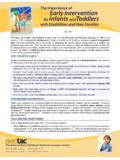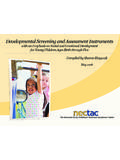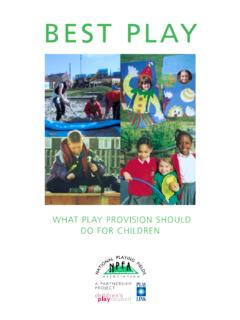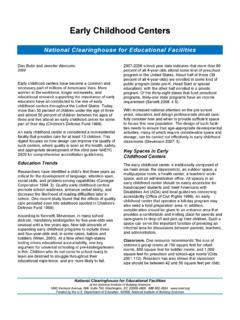Transcription of Early Intervention for Infants and Toddlers with ...
1 The Outcomes of Early Intervention for Infants andToddlerswith Disabilities and their FamiliesThe Outcomes of Early Intervention for Infants andToddlerswith Disabilities and their FamiliesThe National Early Childhood Technical Assistance Center919-962-2001 phone 919-966-7463 web emailJuly 2011 The Infants and Toddlers with Disabilities Program (Part C) of the Individuals with Disabilities Education Act (IDEA) was created in 1986 to enhance the development of Infants and Toddlers with disabilities, minimize potential developmental delay, and reduce educational costs to our society by minimizing the need for special education services as children with disabilities reach school Part C is not intended to be a stand-alone program.
2 The intent is to build interagency partnerships among state agencies and programs in health, education, human services and developmental disabilities. CHILD OUTCOMES Part C provides Early Intervention (EI) services to children aged birth to three who have a full range of developmental delays or a medical condition likely to lead to a developmental delay. Outcomes differ according to each child s disability and age at entry into the program. The program helps many children develop skills at a level equal to their peers by age 3. For children with severe disabilities, progress may be slower and children with degenerative conditions may even lose skills, but the program can help to slow or reduce the impact of their disabilities. Highlights of findings on Early Intervention outcomes for Infants and Toddlers with disabilities include: OVERALL DEVELOPMENTAL GAINS.
3 The National Early Intervention Longitudinal Study (NEILS) found that overall outcomes for Infants and Toddlers participating in Part C included: increased motor, social, and cognitive functioning; the acquisition of age-appropriate skills; and reduced negative impacts of their Findings from 2009-2010 data collected by the states also showed that 71% - 76% of the children receiving Part C services demonstrated greater than expected growth across the following domains: 3,4 Social relationships, which includes getting along with other children and relating well with adults. Use of knowledge and skills, which includes thinking, reasoning, problem solving, and Early literacy and math skills; and Taking action to meet needs, which includes feeding, dressing, self-care, and following rules related to health and safety.
4 These children were acquiring skills at a faster rate when they left the program than when they began. 3,4 Between 54% - 62% of the children receiving EI services exited the program functioning within age expectations in these three domains 3,4 COMMUNICATION. Early identification and Intervention has been found to prevent some communication disorders from developing and to lessen the impact of other Infants with mild-to-profound hearing loss who receive appropriate Early Intervention in the first 6 months of life have been found to demonstrate significantly better vocabulary, receptive and expressive language, syntax, speech production, and social-emotional development than those identified Children with hearing loss who receive EI within the first year of life have been shown to have language development within the normal range at 5 years of Very young children with Autism Spectrum Disorders receiving intensive EI services have been found to demonstrate gains in communication.
5 Speech/language and social 11 Intervention beginning before age 3 appears to have the greatest ,11 READING AND MATHEMATICS. NEILS found that 46% of children who had received EI and been at risk of needing special education services did not need special education at kindergarten age. These children were performing just as well in Early reading and mathematics as the general population of children in FAMILY OUTCOMES The Part C program recognizes that families play a crucial role in optimizing their child s development and aims to enhance the capacity of families to meet the special needs of their Infants and Toddlers . Services are based on an Individualized Family Service Plan (IFSP) that is jointly developed by family members and service providers, taking into account the child s developmental needs and the family s concerns and priorities.
6 Part C also recognizes that Infants and Toddlers with disabilities have a right to receive services as part of family and community life within the context of everyday routines, experiences, and activities with familiar people. Early development is best supported when services are provided in the child s home or in places or programs where young children play . 13 Highlights of findings on family outcomes of Early Intervention include: PARENTING SKILLS. NEILS found that 98% of families participating in Part C felt competent in caring for their children s basic needs and 96% felt they knew how to help their children learn and ,15 State 2009-2010 data showed that an average of 90% of families reported Part C improved their ability to help their children develop and POSITIVE OUTLOOK.
7 95% of the NEILS families reported that EI professionals had helped them feel optimistic about their children s future. 14,15 CONFIDENCE. 96% of NEILS parents felt that they knew how to work with professionals and to advocate for services for their ,15 State 2009-2010 data showed that an average of 86% of families reported Part C helped them to communicate their children s needs. 3 RESPONSIVENESS. Early Intervention has also been found to help families and other caregivers alter their style of interaction and more effectively recognize, respond to, and support young children s attempts to ,17 TAKE HOME MESSAGE Early Intervention services to young children who have or are at risk for developmental delays have been shown to positively impact outcomes across developmental domains, including language/ communication,5- 11 cognitive development,2- 4,12 and social/emotional 4,9-11, Families benefit by being able to better meet their child s special needs from an Early age and throughout their ,3,14,15 Benefits to society include reducing economic burden through a decreased need for special ,12 REFERENCES1.
8 Individuals with Disabilities Education Improvement Act of 2004, 20 1400 et seq. (2004). 2. Hebbeler, K., Spiker, D., Bailey, D., Scarborough, A., Mallik, S., Simeonsson, R., & Singer, M. (2007). Early Intervention for Infants & Toddlers with disabilities and their families: participants, services, and outcomes. Final Report of the National Early Intervention Longitudinal Study (NEILS). 3. U. S. Department of Education, Office of Special Education Programs. (Ed.). (2011). Part C SPP/APR 2011 indicator analyses (FFY 2009-2010). Manuscript in preparation. 4. Early Childhood Outcomes Center. (2011). Summary of 2011 child outcomes data. ~eco/assets/ 5. American Speech-Language-Hearing Association. (2008). Roles and responsibilities of speech-language pathologists in Early Intervention : Technical report.
9 6. McLean, L. K., & Cripe, J. W. (1997). The effectiveness of Early Intervention for children with communication disorders. In M. J. Guralnick (Ed.), The effectiveness of Early Intervention (pp. 349 428). Baltimore, MD: Brookes. 7. Ward, S. (1999). An investigation into the effectiveness of an Early Intervention method on delayed language development in young children, International Journal of Language & Communication Disorders, 34(3), 243 264. 8. Joint Committee on Infant Hearing. (2007). Year 2007 Position statement: Principles and guidelines for Early hearing detection and Intervention programs. Pediatrics, 120(4), 898-921. 9. Landa, R. J., Holman, K. C., O Neill, A. H., & Stuart, E. A. (2010). Intervention targeting development of socially synchronous engagement in Toddlers with autism spectrum disorder: A randomized controlled trial.
10 Journal of Child Psychology and Psychiatry, 52(1):13-21. doi: 10. McGee, G., Morrier, M., & Daly, T. (1999). An incidental teaching approach to Early Intervention for Toddlers with autism. Journal of the Association for Persons with Severe Handicaps, 24, 133 146. 11. Woods, J. J., & Wetherby, A. M. (2003). Early identification of and Intervention for Infants and Toddlers who are at risk for Autism Spectrum Disorder. Language, Speech and Hearing Services in Schools, 34, 180 193. (2003/015 12. Hebbeler, K. (2009). First five years fund briefing. Presentation given at a Congressional briefing on June 11, 2009, to discuss Education that works: The impact of Early childhood Intervention on reducing the need for special education services. 13. Dunst, C. (2006). Parent-mediated everyday child learning opportunities: I.)











